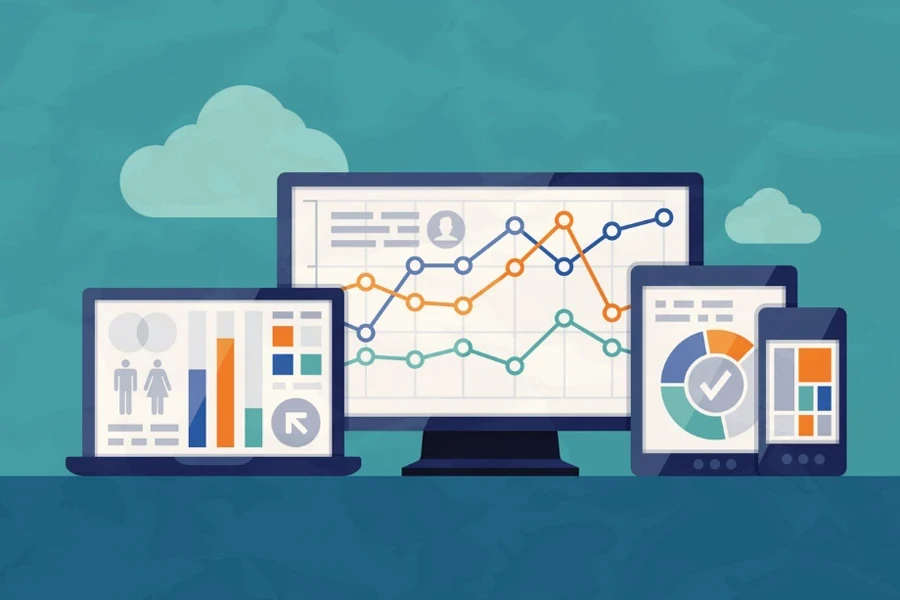Brands are ditching the guesswork and relying on real customer data to understand what customers want, how they shop, and what makes them tick. Instead of pegging on ideas, you can track real numbers and see exactly what’s working.
Read on to learn how to tap into new markets before anyone else and nip any bottlenecks using data-driven marketing hacks.
Table of Contents
Essential tools for collecting marketing data
Website and traffic metrics for marketing analytics
Social media metrics for measuring your online business success
Email marketing metrics
Analyzing and interpreting data to optimize marketing campaigns
Summary
Essential tools for collecting marketing data

1. Surveys and feedback
There’s no simpler way to find out what your customers think. You can use email, your website, or even chat with them in person. Tools like SurveyMonkey or Google Forms can make it easier to resonate with the buyer’s sentiments. If, for instance, you’re running a clothing store, you’ll find out more about the styles people are into right now by using surveys.
2. Web analytics
Web analytics shows you how people use your website, and Google Analytics is popular for this, but other tools like Adobe Analytics or Hotjar still exist. If you have an online store, these tools can help you see where people are leaving your site without buying anything.
3. Social media insights
Don’t forget about social media, as it’s full of what people think about your brand. Tools like Hootsuite or Sprout Social can help you make sense of all that chatter. A tech company, for example, could use these to see which of their posts people engage with most.
4. CRM tools
There are notable CRM tools to help you keep track of all your customer interactions in one place. Salesforce is a big one, but there are others like HubSpot CRM or Zoho CRM. Think of a software company that could use CRM tools to tweak its emails based on each customer’s history.
Website and traffic metrics for marketing analytics

1. Page views and sessions
Imagine a revolving door. Each time it spins, there’s a page view. But if someone walks through that door and browses around for a while, that’s a session.
Page views tell you how often your content is being seen, while sessions give you a clearer picture of website visits. By analyzing both, you can see which content is popular and when your peak visitor times are.
2. Bounce rate
This metric tells you the percentage of visitors who leave your site after viewing just one page. A high bounce rate might mean your website is confusing, your content isn’t relevant, or your loading speed is painfully slow.
As a result, this may prompt you to improve things like page design, content quality, and loading times to keep visitors engaged.
3. Conversion rate
This is the golden metric—it measures the percentage of visitors who take a desired action, like buying something or signing up for your newsletter. By tracking conversion rates, you can see how effective your marketing campaigns and website are at achieving your business goals.
Social media metrics for measuring your online business success

1. Engagement rate
The engagement rate measures how well your content resonates with your followers. It considers likes, comments, and shares relative to your follower count. High engagement rates indicate that your audience is interested in and interacting with your brand.
This way, you get to know what content works best and tailor your future posts to keep the conversation flowing.
2. Follower growth
This metric tracks your follower count’s increase (or decrease) over time. It simply indicates your online presence and brand popularity. Steady follower growth means your content engages and attracts new fans, while stagnation or decline might signal a need to rethink your social media strategy.
3. Impressions and reach
Impressions tell you how often your content is displayed, while reach measures the number of unique users who see it. These metrics show how visible your content is, as well as the potential size of your audience.
High impressions and reach indicate that your content is being seen by many people. As a result, you’ll evaluate your strategy and optimize your posts for optimal impact.
Email marketing metrics

Here’s how to keep your audience in the loop using email marketing metrics:
1. Open rate
This tells you the percentage of recipients who bothered to look at your email. For instance, if you sent 100 emails and 20 were opened, your open rate is 20%. It reflects the effectiveness of your subject lines and the sender’s reputation.
A high open rate, say 40%, indicates that your audience is interested in what you have to say. Use this metric to refine your subject line strategies and maintain high visibility in their inbox.
2. Click-through rate
CTR measures the number of recipients who click on a link within your email. It indicates how well your email content is driving them to take action. High CTRs suggest compelling content and strong calls to action (CTAs). Use the CTR to know what works and replicate those strategies to boost engagement and conversions.
3. Unsubscribe rate
This metric shows the percentage of recipients who opt out of receiving future emails, so you can know if you’re annoying them. In other words, it helps you gauge the relevance and frequency of your content. A high unsubscribe rate might mean your emails are too frequent or not valuable to recipients.
Analyzing and interpreting data to optimize marketing campaigns

Setting benchmarks and KPIs
Marketing isn’t about throwing spaghetti at the wall and hoping it sticks. You need a way to track progress and see if your efforts are paying off. That’s where benchmarks and KPIs come in. Benchmarks are like guideposts on a hike, giving you a general idea of how you’re doing compared to others in your industry.
KPIs are your specific goals—the things you absolutely want to achieve with your marketing. For instance, an online store might set a 5% click-through rate benchmark for its email campaigns, which is what similar stores typically see.
Then, its KPIs could be things like open rates (how many people open the emails), conversion rates (how many people who click on an email end up buying something), and return on investment (how much money it makes back for every dollar it spends on marketing).
Segmenting data for deeper insights
Not all your customers are the same, right? Some might be young tech enthusiasts who live for the latest gadgets, while others are seasoned professionals focused on practicality.
Segmenting your data means dividing your customer base into smaller groups based on things like age, how they behave on your website, or what they’ve bought in the past. In the end, you get to tailor marketing messages to each group while boosting the overall engagement rate.
Identifying trends and patterns
Data is like a treasure trove of hidden insights waiting to be discovered. By analyzing trends and patterns in your data, you can understand how your customers’ preferences and behaviors change over time.
This scales your marketing efforts, letting you anticipate trends and adjust your campaigns to stay ahead of the curve. Use Tableau as the magic decoder ring for your data. It’s a data visualization tool that helps you see trends and patterns come to life, even if you’re not a data whiz.
Charts, graphs, and colorful visuals make it easy to understand what your data is really telling you.
A/B testing and experimentation
Sometimes, the best way to determine what works best is to test it using a tool like Google Optimize. A/B testing is one of the true-and-tested ways of comparing two different versions of something, like your website homepage or an email campaign, to see which one performs better.
Imagine showing half your website visitors one version of your homepage with a “Shop Now” button and showing the other half a version with a more subtle call to action.
Summary
Today, data is king, and using it effectively is the key to surviving (and thriving!) in a market that’s constantly on the move. The more a brand dives into data analytics, the better it understands its customers. They learn what makes them tick, what they love (and hate!), and what kind of messages resonate most.
This lets them craft marketing campaigns like laser strikes—precise and hitting the right target audience. Customer preferences can change on a dime. But with data-driven marketing, you don’t have to rely on guesswork or gut feelings.
You can combine a startup’s agility with a giant corporation’s deep customer insights. You can create personalized marketing campaigns that resonate with your audience and drive real, measurable results by leveraging the right tools and techniques.




